AI: Notes From The Dark Side
Scattered thoughts on the future...
Okay. I previously posted on the subject of AI, and promised/threatened more thoughts. Trust me, it’s not that I think you’ve been breathlessly waiting for them, but a thing about me is that once I’ve said I’ll do something, I’ll damned well do it, even if nobody cares, and regardless of whether my impulses have changed in the meantime.
And they have changed, for reasons I’ll explain.
Semi-relevant backstory. About twenty years ago, I decided I’d like to learn a bit of sleight-of-hand. I’d always been charmed by coin magic, so elected not to look into that end of it — because I didn’t want to know how the tricks were done. I was less intrigued by cards so that’s what I set about investigating. I quickly realized card magic is in fact massively more interesting and varied and, well, magical. I had fun with it for a while but then stopped: partly because it involves a truly vast amount of practice to get any good at it, also because by then I’d learned enough to appreciate the art but not so much that I could only ever see the techniques being deployed, rather than being able to continue to enjoy the wonder of the effects.
A similar impulse was what led me to first dig into AI art, instead of immediately tackling the area that’s far closer to home — prose. What follows is further musing on the subject, mainly as a prompt for your thoughts. It will be illustrated with some of the results of my current obsession with Midjourney.
The post is kinda long, but then I’m done on the subject. Luckily Substack will only allow a limited number of images per post, or we’d be here all day. To be clear, none of the paintings or photos are “real”. And I’m still an amateur at this (though I do tend to go hard at something when I’m into it). There are people out there producing extraordinary images with prompts as long as an essay: also others getting lucky hits with four words, allowing the AI to do the randomized heavy lifting.
And this is what changed: I approached the subject of AI art with a judgmental sneer and a furrowed brow of concern for the fate of fellow creatives, but have become utterly captivated by the empowerment, by the sheer fun, of being able to “create” “art” at will. My artist friends may begrudge me that, just as I may get uptight about the people out there who’re suddenly able to produce whatever prose they want.
The truth is that we’re both on borrowed time, because the genie is already out of the bottle — and thus the question shifts to that age-old prompt for writers:
What happens next?
Firstly, the “truth” of it…
By “truth” I mean here the implications of AI for news, and our perception of the world. The avalanche of fake photos (like the one of Trump being arrested at the end of my last post on the subject) and the endless deepfake videos we can expect to see, especially in the political arena. I produced the photo above for a deck I’m working on, and yes it took some experimenting with complicated prompts to get there, and I knew exactly what I was looking for, but still. It’s kinda freaky. That man doesn’t exist.
This is, sadly, simply a fact, an unavoidable new feature of the world — and how we’re going to deal with it is a whole separate discussion. Someone on Twitter recently shared a principle with me that I’d never heard expressed so clearly before: “Brandolini’s law, also known as the bullshit asymmetry principle, is an internet adage that emphasizes the effort of debunking misinformation, in comparison to the relative ease of creating it in the first place.” This is what we’ll be up against.
So I’ll park it for now except for saying that, unless everybody agrees on some kind of mandatory and indelible watermarking for fake news, fact-checking and critical thinking are going to be increasingly crucial skills if you want to have any idea of what’s happening in the real world. Seeing is no longer believing.
The art
One of the most fun things to do in Midjourney is create images “in the style of” an artists — or even a combination of them. That has obvious implications for the artists themselves: they — and probably writers, and musicians very soon — will be forced to create and maintain their own catalogues raisonné: a comprehensive list of what they have genuinely created, so real works can be distinguished from fakes. No longer do you require a talented craftsperson toiling away with real paint to produce fake work: you now merely need a person like me, who doggedly messes around with prompts.
The above image, for example, is Midjourney’s version of “Frankenstein’s monster” — and yes, it’s smart enough to need that qualification: my first attempt without the possessive and “monster” produced a picture of the inventor instead — “standing on a beach in California, in the style of Jeremy Mann”. It took some fiddling with prompts and variations to get there, but really that’s an art director’s job, not an artist’s — and so the actual artist has been cut out of the loop.
Here’s another, of a woman in Paris:
I love it, and love that I now have this image, which didn’t exist — and never would have, without me. A tiny part of that enjoyment is the notion that it was me, to some tiny and compromised degree, who “created” it.
Sidebar: What’s intriguing to me is how so many of the images I produce with AI look like they’re illustrating the kind of novels or short stories I write. My sensibility and taste is being reflected through my prompts and styles I play with. The next image, for example, really makes me want to sit down and write… and so an image I produced through written prompts becomes a visual prompt for me to write.
That picture took me bare minutes to produce. Concept and illustrative artists are truly about to go through some things, and I feel for them… not least because writers will go through the same wringer.
The prose
After my last piece on IA, a person in the comments shared up a version of the nursery rhyme “Jack and Jill” written in the style of Michael Marshall Smith. I wouldn’t say it quite captures my ineffable genius, but it mentions smoking and is kinda noir while discussing quotidian matters, so, yeah… it’s not bad.
(One question I have is what happens the next time the AI is trawling the web looking for shit to mimic: does it take that poem and accept it as part of my so-called oeuvre? Do fake in-the-style-of prose or images start being rolled into the AI’s understanding of a particular style? Does the whole thing evolve to the point where there’s an Michael Marshall Smith out there who’s developing along his/its own track, and possibly getting much better than me?)
I’m sure one of the areas AI will get most traction is in television. If you feed in the plot and beats of all the successful shows of the last twenty years, an AI will be able to come up with endless variations upon that source material, and some of the results will be pretty good. Sure, you’ll need to build in some nuance, allow for the passing of time, and factor in this year’s fad, but I suspect the building blocks of televisual entertainment won’t represent too hard a challenge for a well-trained AI.
Of course, to an extent, that AI already exists — in the shape of execs in TV studios. Hour after hour, day after day, they’re presented with potential shows by young hopefuls (and old and bitter workhorses) and what they (along with the marketing and Business Affairs departments) seek to do is figure out which is going to land, and make everybody (well, not the writers, which is why a WGA writers’ strike is looming) a ton of money. This is similar, except (as with the art in this post) it cuts the writers themselves out of the picture — apart from, perhaps, as people to be brought in to sand off a few edges, punch up the dialogue, or add a beat of originality. (And sometimes, as in the case of this last paragraph, a shit-ton of parentheses).
How well will it work? Depends how “human” the AIs get.
One of the key guidelines I give people preparing to pitch a project is: Don’t just tell us what happens — tell us what it’s about. A human writer will be aware of the distinction, consciously or otherwise. An AI isn’t, at least not for now. Sure, if specifically asked then it’ll be able to construct a sentence that begins with “This show is about…” and provides a summary of events — but that’s not the same.
Similarly, as the writer’s adage goes, “The queen died, and then the king died” is a plot, whereas “The queen died and then the king died of a broken heart” is a story.
AIs aren’t there yet either. But they will be. There will come a point where it will be functionally impossible to tell whether certain types of material have been written by a human or machine, when mimicry becomes indistinguishable from authenticity. There are plenty of bumps to be ironed out (much as, in art, many AIs including Midjourney make an awful hash of rendering hands, because while they know what hands look like, they don’t yet grasp the workings of them: the same will be true of their attempt to evoke human behaviors) but a lot of people are striving hard at this, and it’ll get fixed… because there’s money to be made, or saved.
The question becomes what we want out of all this, and where it leaves us.
The matter of intent
I regularly visit a site called Product Hunt, because I’m a total software nerd and always on the hunt for something new to download, try, and ultimately throw away when I realize the app I’m already using is better. (The only person I know who’s as bad as me this way is Julian Simpson, and you should totally be reading his Substack too. Not now obviously. Stick with me for a minute).
Product Hunt is choked with AI crap right now. For anything you can think of needing to type — right down to writing an obituary for a dead relative, for crying out loud — there’s now a dedicated AI to do it for you. This makes me realize that part of the big shift that’s going to happen across the creative board is the notion and status of a “creator”.
For now, an implicit part of our regard for anything created is precisely that connection to its creator. This is deeply-bedded in our psychology, reflected in a variety of things including religion. It’s not enough for Earth and everything on it to simply be — the notion of a creator confers (at least in a lot of people’s minds, and historically) a vast additional resonance. It is the creator that gives the creation meaning. Otherwise… it’s just a thing.
This operates in art all the time. Show someone a piece of paper with a random squiggle on it, and nobody cares. Reveal a Picasso signature at the bottom of the page, however, and suddenly they’re in the presence of art. Part of this is simply a question of increased market value, but it’s also because the squiggle being “by” Picasso comes not merely with historic context and cost, but a massive kick up the perceived ladder of creators, and everything that comes along with that. Picasso, a great artist, presumably meant something by this shape — it was either a stylized attempt at representation, or at perversely not representing something, or at very least a conscious exercise in demonstrating how a trivial effort on his part made something (slightly) interesting and thus valuable, which still demonstrates intent.
And this is the heart of it. It doesn’t matter how great computers get at dishing out prose or conjuring images, or music, or TV. Does a machine mean anything by what it produces? Is there any meaningful degree of intent? That’s what moves us. Certainly we can develop emotional relationships with machines. We give our cars names. Swear at the toaster. Mutter at Autocorrect when it gets something wrong. But have any of us stood as a family around the washing machine, and given it a round of applause? No. Performing a mechanized function just because a human pushed a button does not qualify, and that reduces the meaningfulness of the act.
Intent is critical to human behavior, as evidenced by the fact it’s also a key determinant in law. The difference between manslaughter and murder is primarily one of intent. It’s relevant in many other cases too, including the current suit filed by Dominion against Fox News. There’s no doubt that Fox spread vast amounts of misinformation about the 2020 US elections — the legal question is whether there was intent to deceive. I think we know the answer to that already, but that’s by the by.
Intent is important because it speaks to the nebulous concept of meaningfulness, and this is where language (as often, when stared at hard) starts to get slippery on us. Let’s take the example of the AI that’ll write a eulogy for someone.
What is an obituary or eulogy for? What does it do?
Three things. It is a collection of words designed to encompass a person’s life for an audience, after their death. An AI could do this, sure. But part of the point is for the audience to know these words have been compiled by a person who knew the deceased, and thus they are bringing that love or friendship to bear. An AI can’t do that. There’s the question, however, of what difference it would make to the audience if they didn’t know the eulogy had been written by AI. Would they be able to tell? Perhaps not, if they didn’t know the alleged human writer very well.
But what an AI absolutely can’t fulfill is the third function. Writing an obituary or eulogy is an act of love but also part of the process of grieving. It makes you conjure the person in your head, and confront their passing. This can be a critical step in accepting that your relationship to them has changed. Not ended, but changed.
This is simply not possible for an AI — and by giving them the task, you’ve missed out. You can’t sub-contract grief. You have to do it yourself.
Not really a conclusion…
Producing AI “art” does take a little work, and time. You have to learn the software and experiment a lot. You have to tinker, think, put in the hours. Version 5 of Midjourney is better for photorealism, for example, whereas Version 4 often yields nicer results with painting. Some styles generate better results at particular aspect ratios, and the sampling bias sometimes becomes evident: when “making” a fake Mann, for example, I’ll often add a qualifier to reduce the greens. There is a truly vast range of other qualifiers that can be leveraged to tweak results, using them in different ways and orders yields different results. There’s no list of these and no manual — and as I keep emphasizing (possibly a little guiltily), there’s a limit to how far you’ll get without a pre-existing vision.
My suspicion is AI imagery may eventually go the way of the “desktop publishing revolution” in the 1990s, when it became clear that everybody having the tools available to do design didn’t mean everyone was capable of producing design worth looking at. Sure, you won’t now hire a design firm to run up a quick poster for the office drinks party… on the other hand you won’t trust Barry in Accounts to produce your corporate identity work. The same will likely be true of art and photography and music and writing.
But now this post is getting long and I’m clearly not getting any closer to any answers. So I’ll hand it up to you. What do you think?
One truth is that the future leaves nobody untouched. At the top of the piece I mentioned magic, and the other day it struck me how that’s being affected by progress too. Nobody carries coins any more, and a deck of cards is no longer a feature of every home. What was once magical because it used everyday objects to conjure the unexpected or impossible is now an “act”, requiring specific “props”. That changes it. The AI revolution is going to change our relationship to creation.
The bottom line, as I said back at the start, is we’re already after the fact. The AIs are out there. Nobody’s going to be able to corral them back into their virtual pens. We need to ask what (if anything) we as artists and creators can provide that an AI never will be able to. And as another person sagely observed in the comments on the last piece, we crucially need to examine the question of what we, as humans, want the shape of our lives to look like, once many of the tasks that kept us occupied (and paid, importantly) are handled by machines.
Because while the hot topic right now is the fate of artists, AIs will be coming for your job too: including, sooner than most, the jobs of the people who write computer code. The folks out there merrily stuffing AI into everything under the sun will ultimately make their own jobs obsolete.
AI will eat its creators too.
Finally — the picture below is what Midjourney thinks I would look like if I’d been painted by Jeremy Mann. AI is also going to challenge our notions of self, and our egos, by handing up rather more attractive versions (in this case, flattering to the point of obsequious)… and that’s going to be interesting to deal with. Because… I want to be this guy — not the crumpled geezer hunched over a laptop pecking this out.
What happens to us when there are fake humans, too, and we like them more?



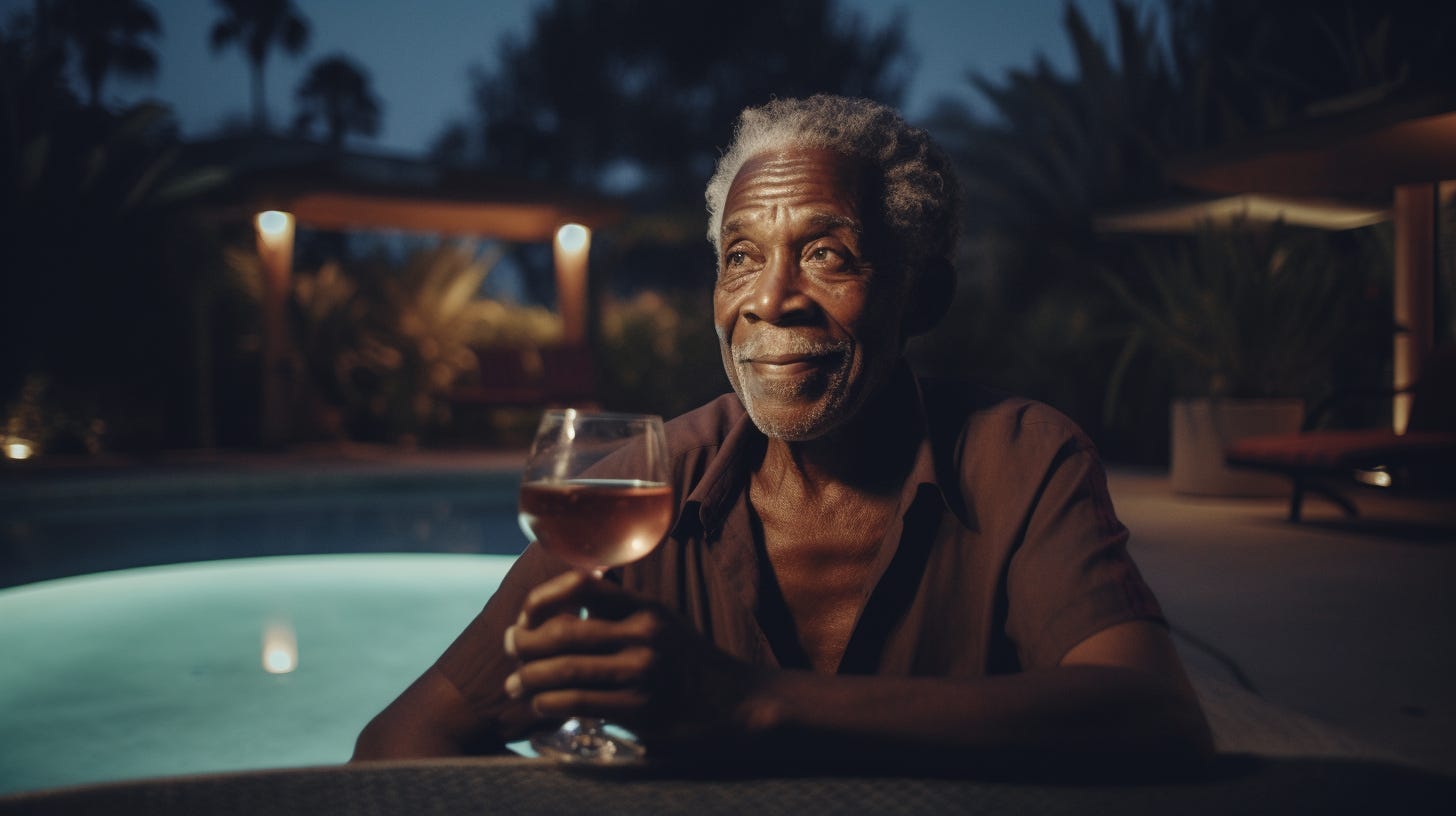

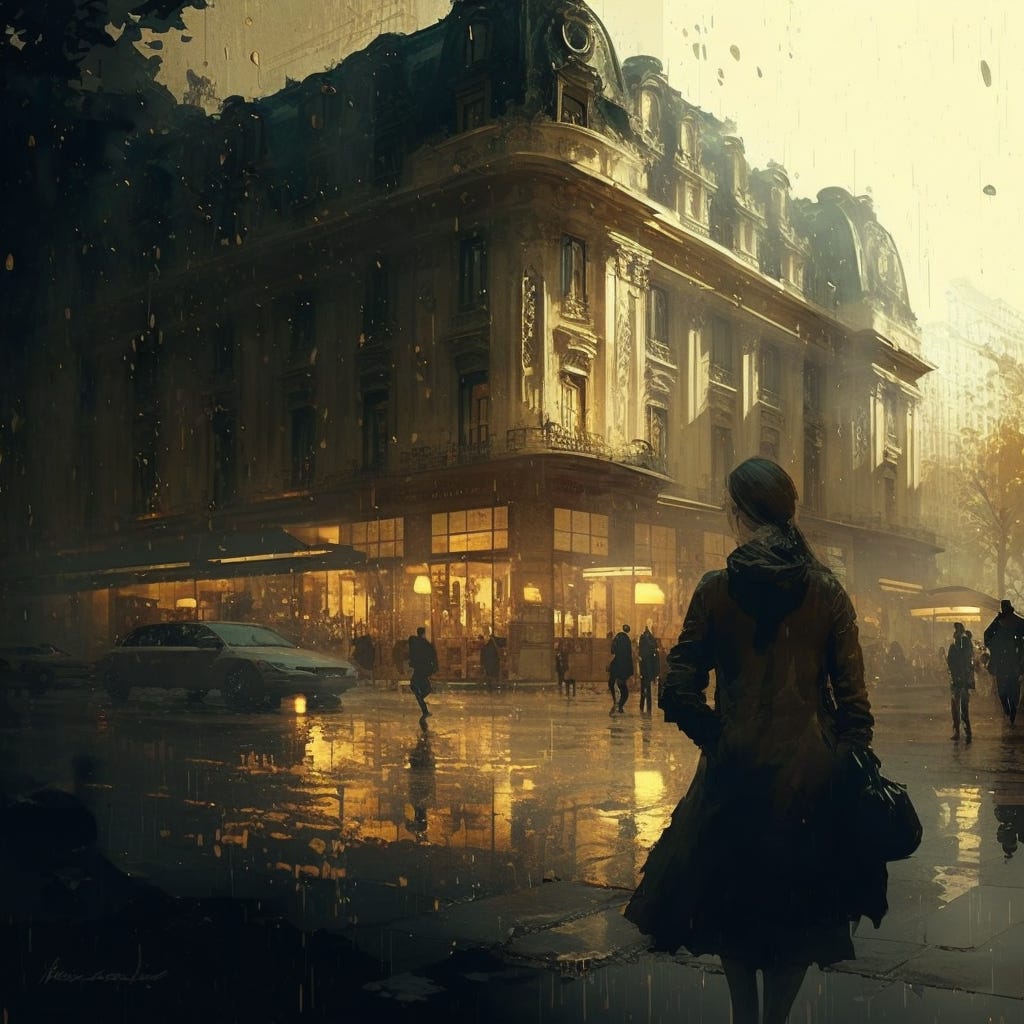
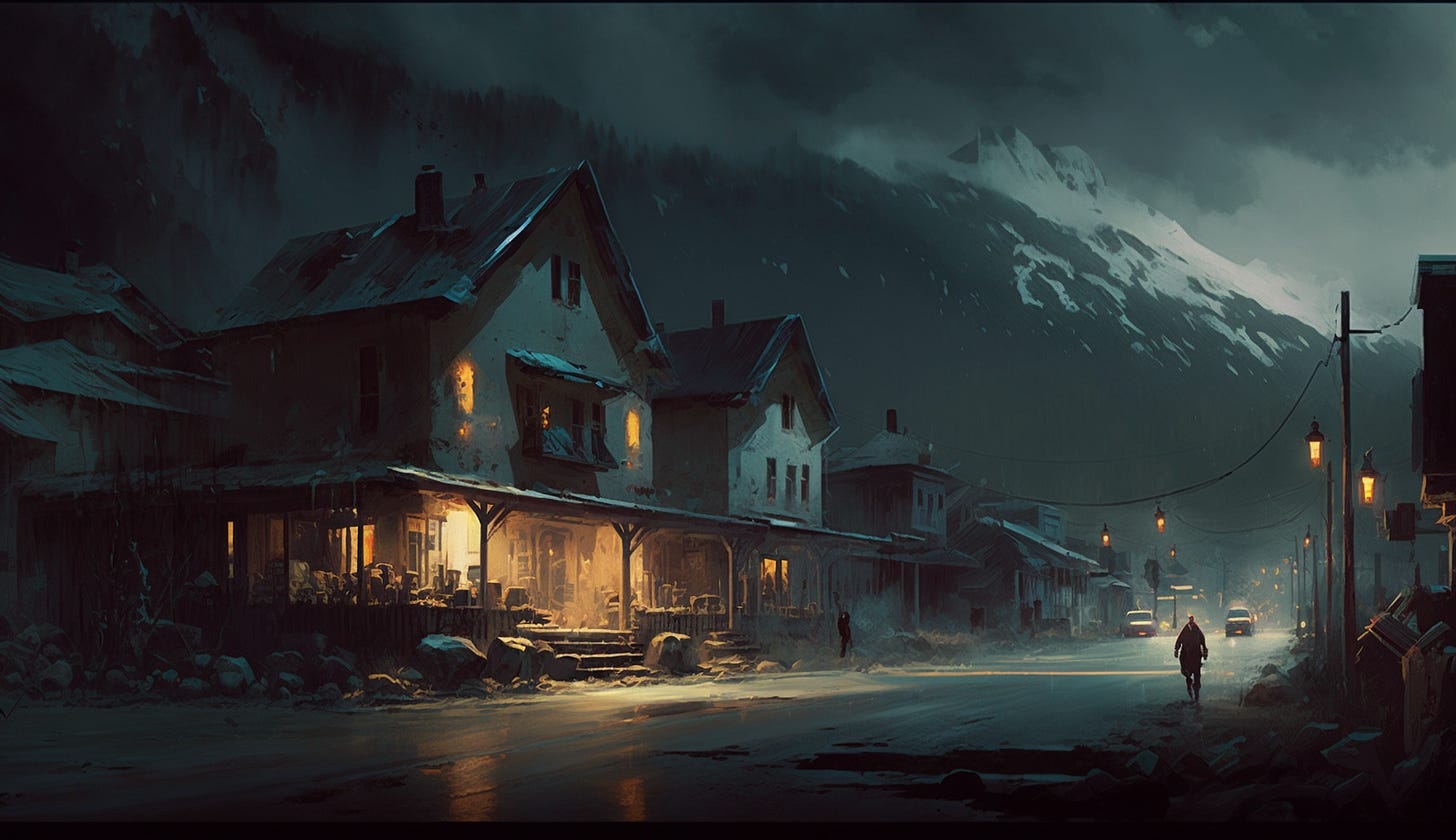

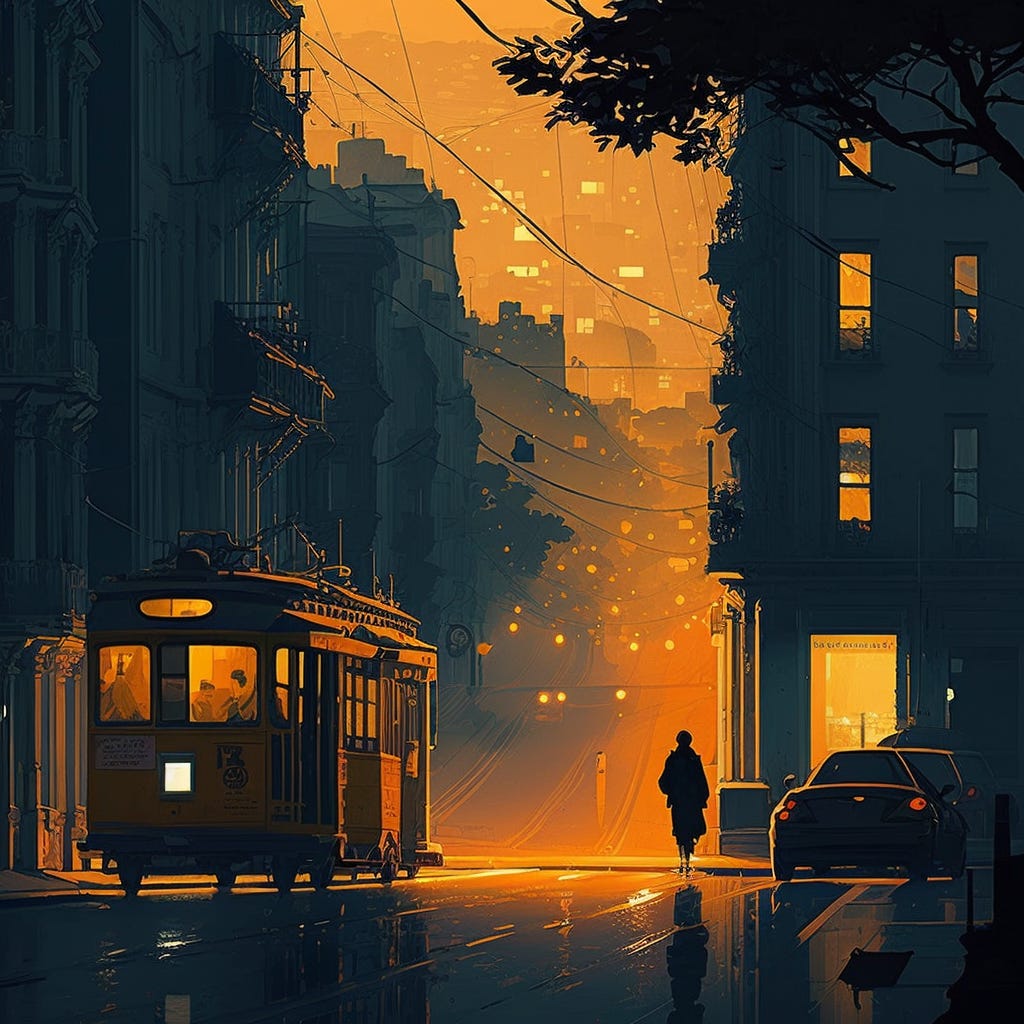
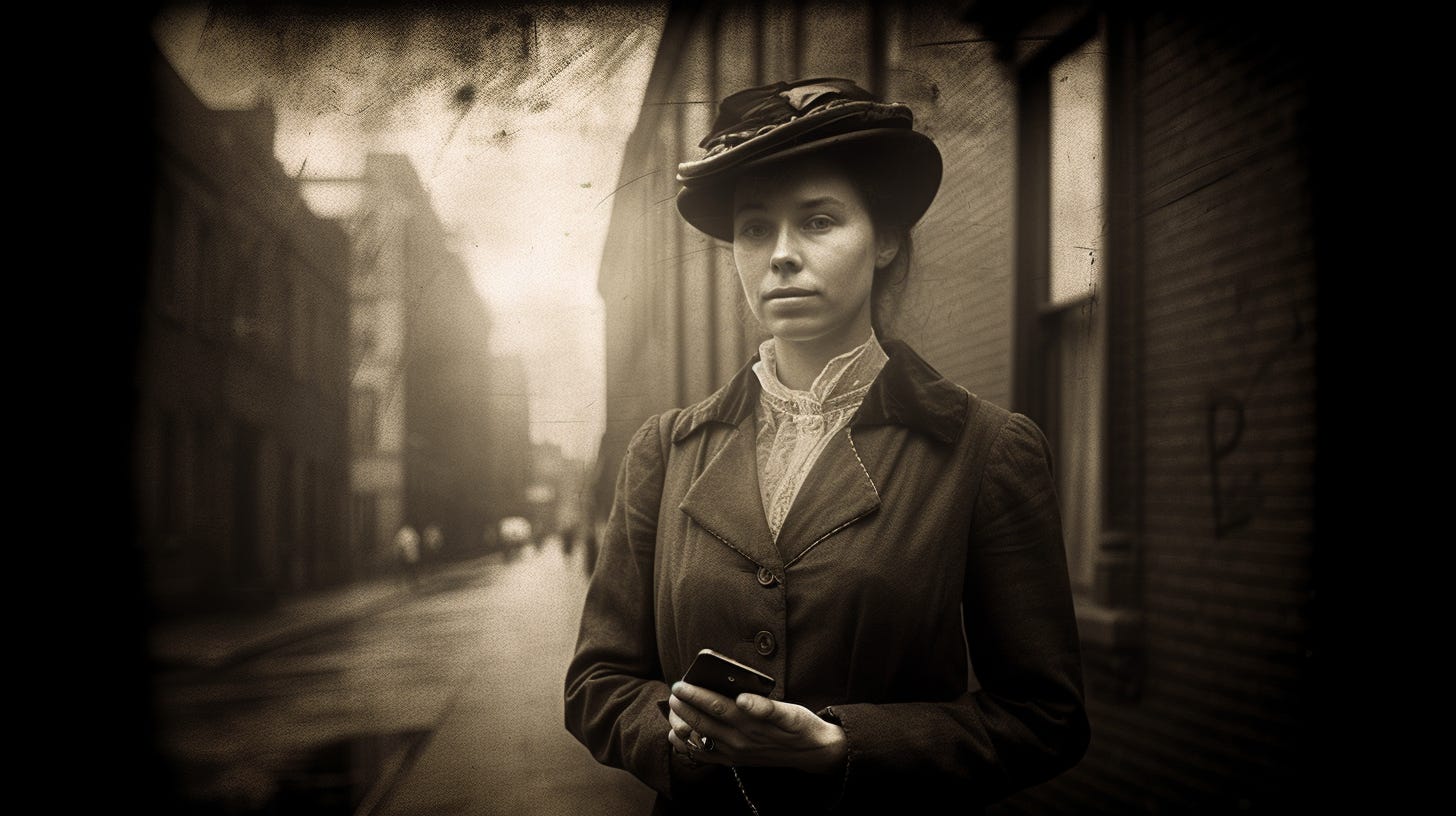
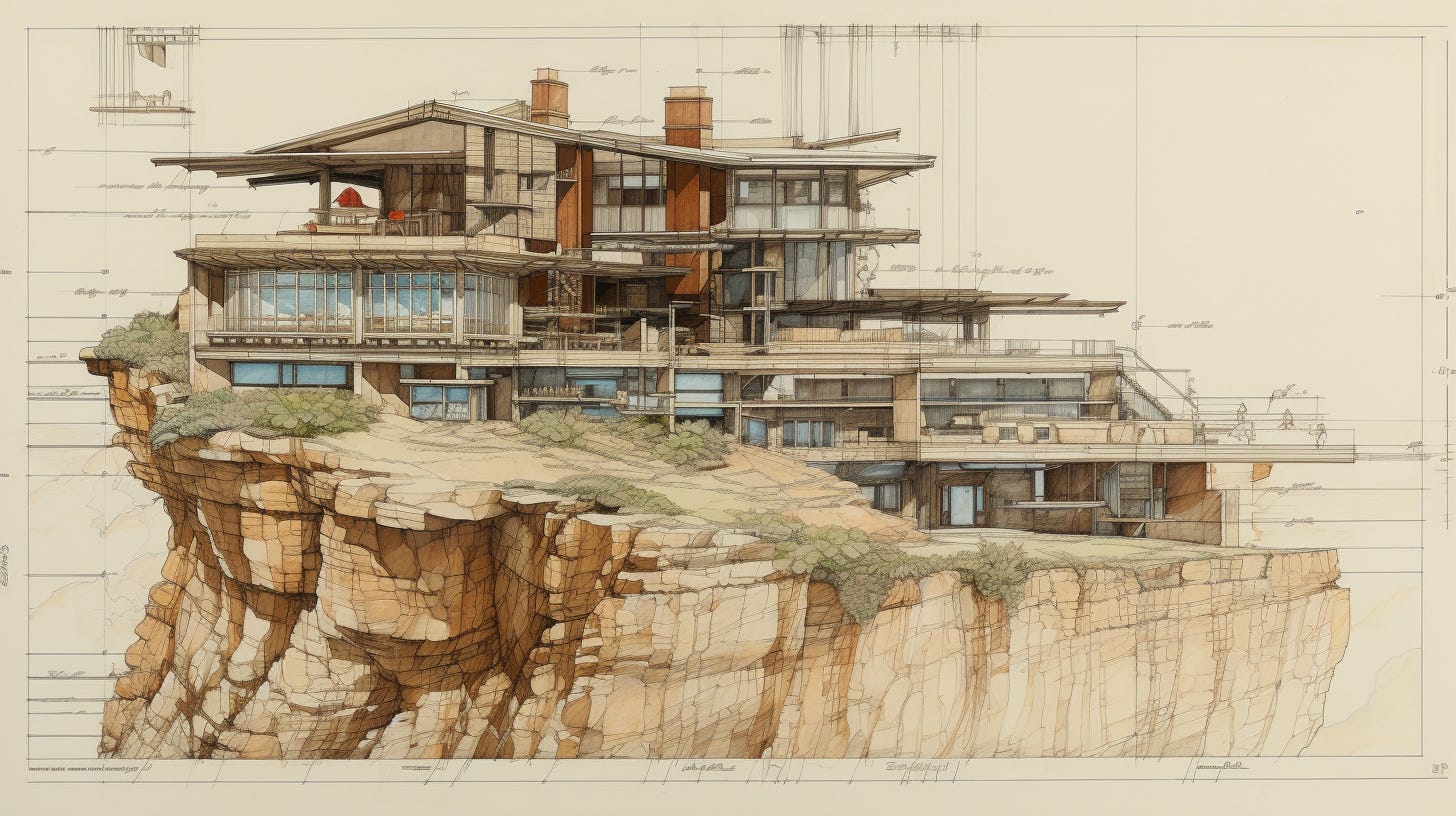
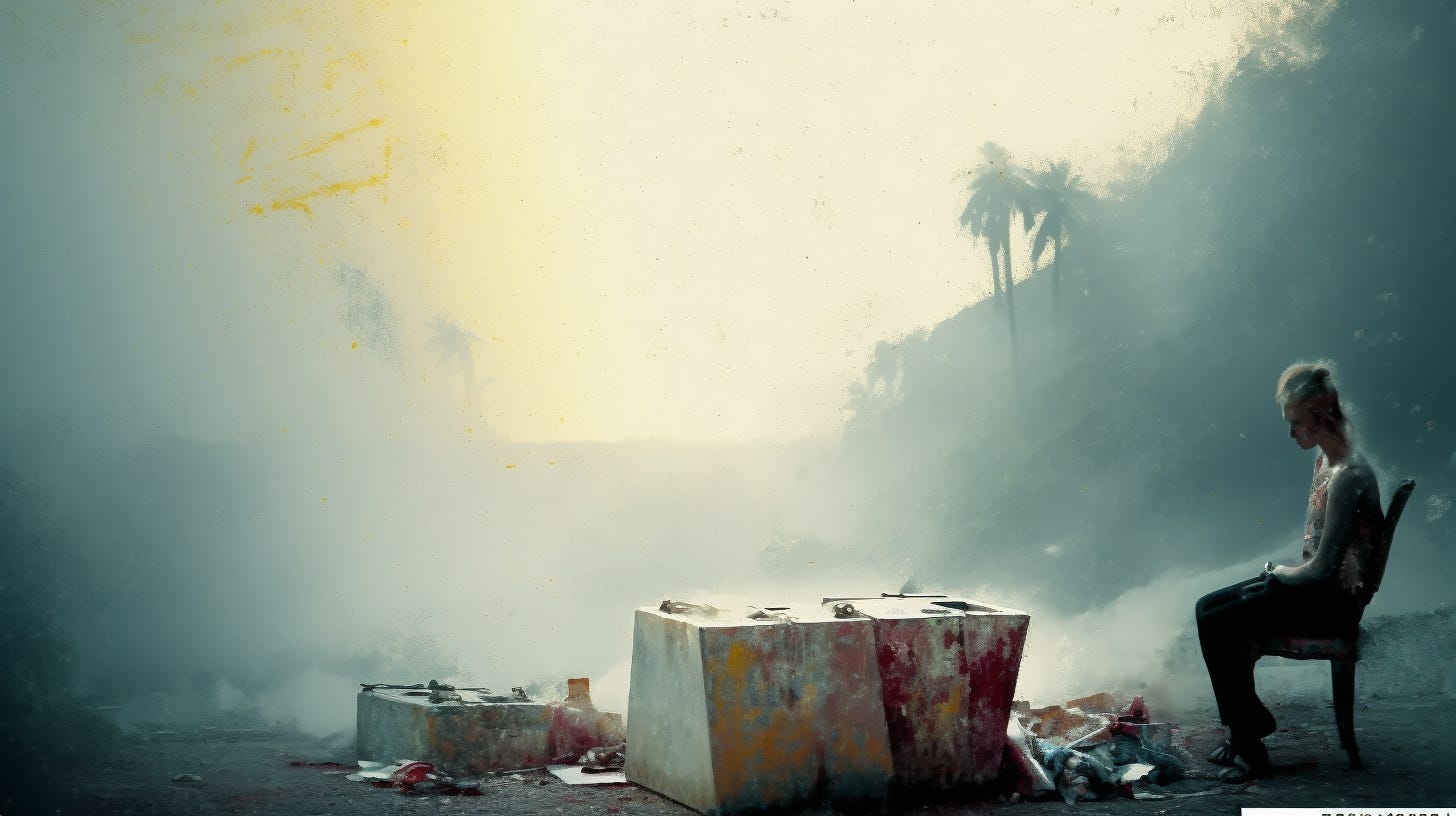
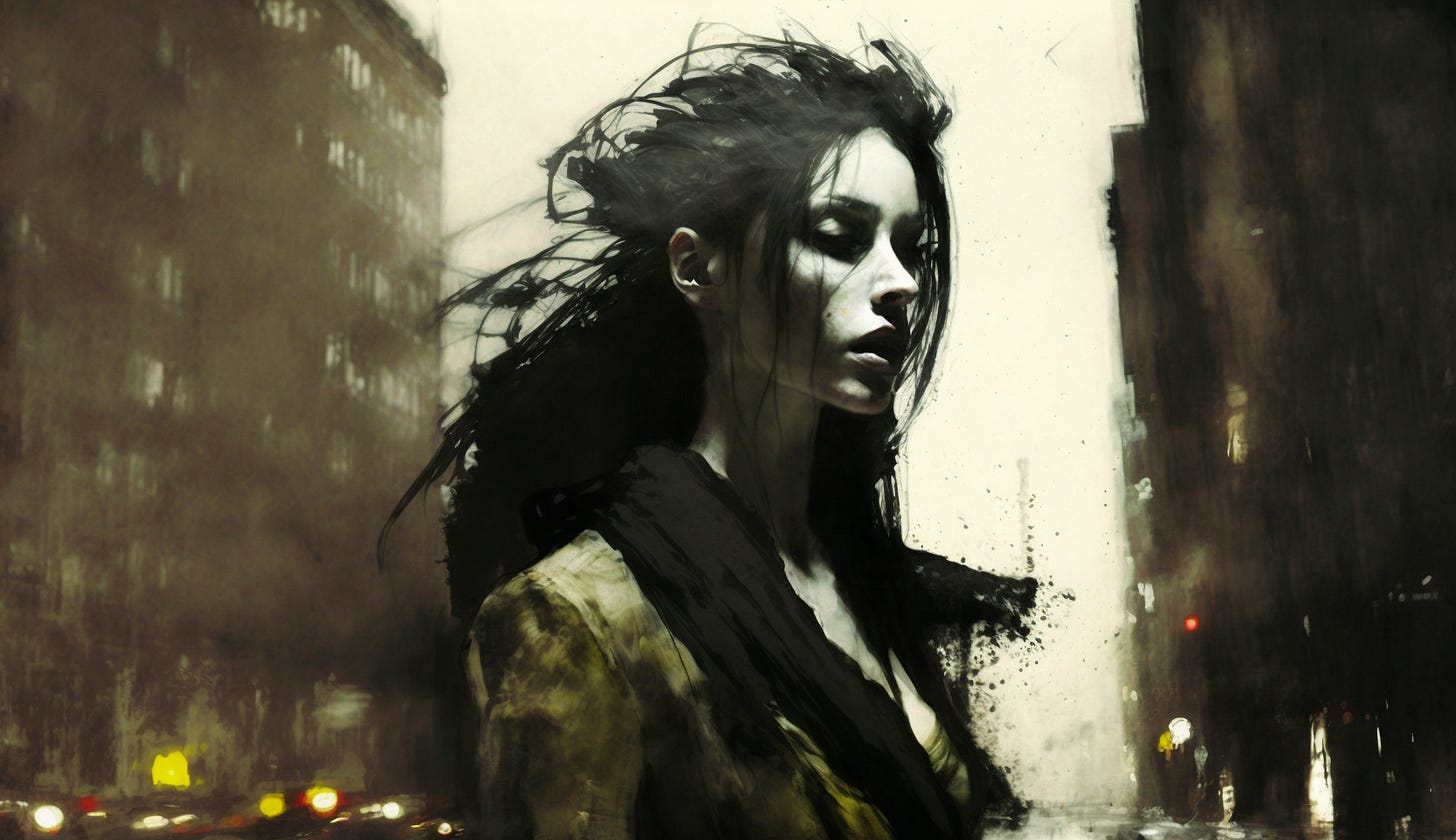

Interesting thought about the role of the creative process to grief in writing an obituary or eulogy. It strikes me that there are many people who have the emotions and care for language, but not the word wrangling skills of someone who regularly writes prose. Just as you've spent a lot of time adjusting and nudging prompts to get a pleasing result with the art, they might sit down and write a list of the qualities which embodies the loved one. Add in words to describe their life and family with name and so on. And then keep reading the results and selecting the best until they came up with something which they would have been able to compose if they'd started on a blank page, but which has taken time and love to create.
I was looking forward to more of your thoughts on this, and you didn't disappoint. Your question about whether future AI will use the artificially generated MMS poem as part of your oeuvre has already been answered I think by the news that ChatGPT and Google's version, Bard, are citing each other's work in their answers now, whether or not that work is accurate. It really feels like a tipping point right now, as we watch notions of truth, creativity, and inspiration dissolve before our eyes. I don't know what's going to happen next, but I can't help, given our track record as a species, feeling rather pessimistic about the outcome.